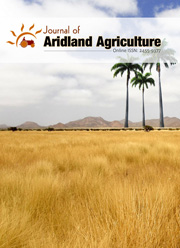Rainfed farming prospects in the low rainfall zone of northern Iraq based on meteorological and soil moisture measurements
DOI:
https://doi.org/10.19071/jaa.2017.v3.3194Abstract
Â
More than 50% of the rainfed region in northernIraqfalls within the low rainfall zone receiving between 300 and 400 mm of mean seasonal rainfall. Several natural runoff plots with access tubes were used to measure soil moisture distribution in depth and time. Measurements during two consecutive rainfall seasons were used to forecast the rainfed farming prospects in the low rainfall zone. The first season is considered wet because it received 568 mm of mean seasonal rainfall; the second rainfall season is considered dry because it received 256 of mean seasonal rainfall. The prospects of tillage systems, fertilization and soil moisture conservation for a successful rainfed farming (wheat and barley crops) venture in the low rainfall zone were explored and  a rainfed farming guide for this zone was suggested.Â
Â
Downloads
References
REFERENCES
Abdullah AS. Minimum tillage and residue management increase soil water
content, soil organic matter and canola seed yield and seed oil content in the
semiarid areas of northern Iraq. Soil & Tillage Res. 2014; 144: 150-155.
Doi: 10.1016//j.still.2014.07017.
Ahmed RA. Physiology of Field Crops and Their Growth under Dryland
Farming Conditions. Mosul University Press, Mosul-Iraq; 1987
Al-Fakhry AK. Dryland Farming. Mosul University Press, Mosul-Iraq; 1979
Al-Fakhry AK, Ali YA. Effect of plant densities and fertilization on yield of two
wheat cultivars under rainfed conditions in northern Iraq. Mesopt. J. Agric. 1989;
(1): 221-236.
Al-Fakhry AK, Sultan AM. Studies on rotation and tillage effect on
wheat yield under dryland farming in northern Iraq. Paper presented at the
Symposium on Dryland Farming, May 5-10, Amman, Jordan;1979
Alrijabo AA. Effect of zero tillage farming system on growth, yield and
its components for bread wheat, durum wheat and barley crops in the moderate
rainfall area of the Ninewa province. Mesopot. J. Agric. 2014; 42 (1): 242-254.
Al-Tahan YH, Rajabow SA. The effect of different plow types on wheat yield
under rainfed farming in northern Iraq. Mesopot. J. Agric. 1989; 21(3): 249-258.
Barber SA. Efficient fertilizer use. J. Paper No. 6040. Purdue University
Agricultural Experiment Station. West Lafayette, Indiana, USA; 1976
Hussein MH. Direct groundwater recharge by rainfall in a region with
a semiarid Mediterranean type climate. In: Geherls H, Peters NE, Hoehn E,
Karsten J, Leibundgut C, Griffien J, Webb B, Zaadnoordijk WJ, eds.
Impact of Human Activity on Groundwater Dynamics. International Association of
P. 99-105. . Hydrological Sciences (IAHS) Publ. no. 269. Wallingford, UK; 2001
Hussein MH, Awad MM, Abdul-Jabbar AS. Distribution of rainfall, runoff and soil
moisture storage in the low rainfall zone of northern Iraq. J Environ. Hydrology.
; 13, Paper 26.
International Center for Agricultural Research in the Dry Areas (ICARDA).
New Research Approaches to Improve Dryland Agriculture. CGIAR Research
Program on Drylands Production Systems. ICARDA, Addis Ababa, Ethiopia; 2013.
IPCC (Intergovernmental Panel on Climate Change). Climate Change. Fourth
Assessment Report. Cambridge University Press, Cambridge, UK; 2007
Manfreda S, Scanlon TM, Caylor KK. On the importance of accurate depiction of
infiltration processes on modeled soil moisture and vegetation water stress.
Ecohydrology 2010; 3:155-165. Doi: 10.1002/eco.79
Mikha RG, Amin ZA, Yunis AF. Effect of different tillage systems on some
soil physical properties and barley growth. Mesopot. J. Agric. 2013; 41(1):1-8.
Mutchler CK. Runoff plot design and installation for soil erosion studies.
Report No. ARS-41-79, USDA-ARS; 1963.
Patrignani A, Godsey CB, Ochsner TE, Edwards JT. Soil water dynamics
of conventional and no-till wheat in the southern Great Plains. Soil Sci.
Soc. Am. J. 2012; 76: 1768-1775. Doi: 10.2136/sssaj2012.0082
Pedro V, Carvalho M, Serralheiro R, Maia R, Ramos V, Oliveira B. Climate change
impacts on rainfed agriculture in the Guadiana river basin (Portugal).
Agriculture Water Management. 2015; 150: 35-45.
Doi:10.1016/j.agwat.2014.11.008
Rockstrom J. Water for food and nature in drought-prone tropics: vapour
shift in rainfed agriculture. Royal Society Transactions B: Biological Sciences.
; 358 (1440): 1997-2009.
Rockstrom J, Karlberg L, Wani SP, Barron J, Hatibu N, Oweis T, Bruggeman A,
Farahani J, Qiang Z. Managing water in rainfed agriculture- The need for
a paradigm shift. Agriculture Water Management. 2010; 97: 543-550.
Doi: 10.1016/j.agwat.2009.09.009
Oweis T. Supplemental Irrigation: A Highly Efficient Water-Use Practice.
International Center for Agricultural Research in the Dry Areas. Aleppo, Syria;
Shafiq J, Kedar AA. Effect of nitrogen and phosphate fertilization on the growth
characteristics of four broadbean varieties grown under rainfed condition in
northern Iraq. Mesopt. J. Agric. 1989; 21(2): 257-276.
Troeh FR, Hobbs JA, Donahue RL. Soil and Water Conservation for Productivity and Environmental Protection, 4th edn. Prentice Hall, NJ, USA; 2004.
Van Doren DM Jr., Allmaras RR. Effect of residue management practices on the soil
physical environment, micro climate and plant growth. In: Oshwald WR, ed.
Crop Residue Management System, Am Soc Agronomy Special Publ. No. 31,
Madison, Wisconsin, USA; 1978. P. 49-83.
Wang A, Baoyuan L,Wang Z, Liu G. Monitoring and predicting the soil water
content in the deeper soil profile of loess plateau, China. Int. Soil and
Water Conservation Res. 2016; 4: 6-11. Doi: 10.1016/j.iswcr.2016.02.001
William JD, Wuest SB. Soil water dynamics in continuous winter wheat in the
semiarid Pacific Northwest, USA. Soil Sci. Soc. Am. J. 2014; 78: 571-578.
Doi: 10.2136/sssaj2013.09.0414.





 .
.